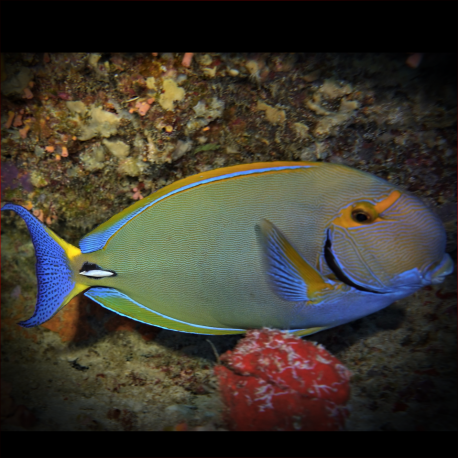More info
Datasheet
| Minimum Tank Size | 1200 litres / 317.01 US gallons |
| Maximum Size | 54cm / 21.26inches |
| Reef Compatible | Always reef safe |
| Temperament | Mostly peaceful but might be aggressive towards similar species |
| Temperature | 22.2°C / 71.96°F - 25.6°C / 78.08°F |
| Specific Gravity | 1.020-1.025 |
| Carbonate Hardness | 8-12 |
| pH | 8.1-8.4 |
General Description
The Eyestripe surgeonfish, scientifically known as Acanthurus dussumieri, belongs to the Acanthuridae family. It exhibits a fascinating characteristic where some species within the Acanthurus genus mimic juvenile Angelfish as a self-defense mechanism against predatory fish. This mimicry makes them challenging to identify solely from images of adult fish. Surgeonfish typically reside in the Indo-Pacific region, ranging from East Africa to the Hawaiian and Line Islands, with their distribution extending north to southern Japan and south to regions including the Rowley Shoals, southern Great Barrier Reef, and Lord Howe Island.
Aquarium Suitability
Eyestripe surgeonfish are suitable for aquariums with care, necessitating specific demands that include a minimum tank size of 1200 liters, adequate hiding places among live rocks, and ample space for swimming. They thrive in well-established aquariums with a rich algae supply that is crucial for maintaining their immune system health. While they exhibit mostly peaceful temperament, they may display aggression towards similar species, necessitating caution when introducing multiple Eyestripe surgeonfish to the same environment.
Care and Hardiness
Known for their hardiness, Eyestripe surgeonfish demand a well-maintained tank environment with optimal water conditions such as a temperature range of 22.2-25.6°C, pH levels between 8.1-8.4, a specific gravity of 1.020-1.025, and ideal carbonate hardness (KH) of 8-12. These fish primarily feed on small crustaceans like krill, mysis, and artemia but require a predominantly algae-based diet supplemented with macroalgae like seaweed or nori and microalgae such as spirulina to thrive in captivity.
Reef Suitability
Eyestripe surgeonfish are highly reef-compatible, contributing positively to coral aquariums by aiding in algae control. They rarely disturb corals or invertebrates, with the exception of large Palettes/Blue tangs. Their scalpel near the caudal fin serves as a defense mechanism and can cause significant lacerations, highlighting the importance of handling these fish with care, especially if aggression arises.
Aquarium Setup
When setting up an aquarium for Eyestripe surgeonfish, it is essential to provide a well-established environment with plenty of live rocks for hiding spots and grazing activities. Ensuring a sufficient algae presence on the rocks allows the fish to exhibit natural feeding behaviors. Additionally, offering a varied diet that includes algae-rich foods like Nori seaweed and maintaining a peaceful cohabitation by introducing less aggressive species first can promote a harmonious tank dynamic.
Behaviour
In aquarium settings, Eyestripe surgeonfish are known to spend the majority of their time swimming around and feeding on algae from rocks. They exhibit a peaceful temperament towards other fish species and establish a hierarchy when kept in groups. Providing individual sleeping areas and ample hiding spots can help reduce potential conflicts between fish and minimize stress-induced fatalities in the tank environment.
Feeding and Diet
Eyestripe surgeonfish primarily feed on a diverse array of frozen foods but rely heavily on an algae-based diet for optimal health. Regular feeding of algae-rich supplements such as Spirulina, along with offerings of plant-based fish flakes and Nori seaweed, helps sustain the fish's immune system and supports their overall well-being in captivity.
Dimorphism and Captive Reproduction
Eyestripe surgeonfish showcase minimal dimorphic characteristics, with no significant visual distinctions between males and females evident. While specific information on captive reproduction of this species is limited, replicating natural spawning conditions in controlled environments may support successful breeding efforts and further research into their reproductive biology.
Habitat and Distribution
Eyestripe surgeonfish inhabit various marine environments within the Indo-Pacific region, ranging from East Africa to Japan and the southern Great Barrier Reef. They prefer areas abundant in algae-rich substrates and rocky formations, where they can graze and forage for food. Their distribution encompasses diverse habitats, from the Mascarene Islands to the Line Islands, showcasing adaptability across a broad geographical range.

